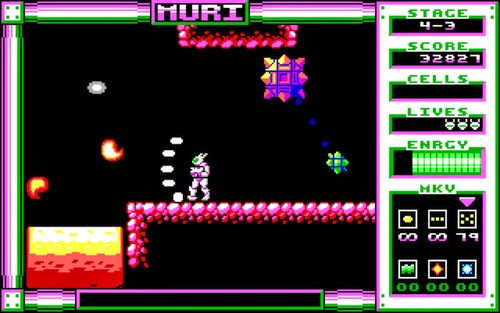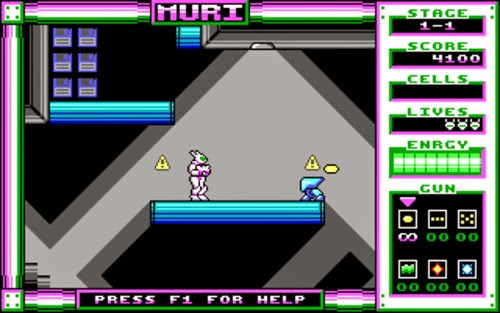A game by Remar Games and Ludosity for PC, originally released in 2013.
Gaming has aged to the point where an entire generation of gamers has joined its ranks without ever experiencing its foundational years. While emulation has given these newcomers a (slightly warped) window through which to view the era, the world of DOS-based gaming remains largely unexplored in the modern age… and MURI is here to fix that.MURI prides itself on exploring its DOS-based heritage, and was heavily influenced by the likes of Commander Keen and Duke Nukem (back when he was 2D… and relevant). The game features a 320x200 EGA resolution with the playable area enclosed in a wide frame and a large HUD. It offers stylized but ultimately gaudy visuals, using the limited 16-color system of the day, and it has no dithering effects, making everything appear stark and solid.
The game has janky scrolling with its limited default framerate of 16 fps, authentically replicating the low framerates of the era. Fortunately, the developer also included a 32 fps “smooth” mode as a favor to modern gamers, which makes the game play more like the sidescrollers of today.
The only music is the track that plays during the title screen and end credits, as per the standards of early DOS-based titles; there is no in-game music. All of the sound effects are meant to mimic the sounds created by an internal computer speaker – with only a single sound effect being played at a time – greatly limiting the range of effects when compared to later computer games that supported sound cards and had MIDI soundtracks.
The game features a mature narrative dealing with life and death, human fear about advances in technology, and even the disappearance of an entire planet. The story, which is told through text intros and cutscenes, centers around research scientists who created an armored exoskeleton called MURI, inciting a war between Mars and Earth over fear that it would be used as a weapon. Then, Mars disappears for no discernable reason, and Earth is laid to waste by a robot army dispatched by warring factions. Adwoa, one of MURI’s creators, dons the suit and heads out to find her family.
The story treads well into the esoteric end of the science fiction spectrum, tossing out what is known about physical reality in favor of unexplained energies and family dramatics. As such, it unironically conjures the spirit of 70’s-era science fiction dramas, neither maligning their shortcomings nor divorcing itself from them.
MURI features a Turrican-style jump that lacks inertia, allowing the player to hold the JUMP button to make Adwoa levitate upward, returning slowly to the ground when the player lets off the button or when Adwoa reaches the apex of her 3x jump. Adwoa can shoot to the left and right, as well as duck and fire. She is also able to jump on enemies to damage them from above, which is a useful strategy when dropping down from higher platforms, especially given that many enemies are unable to shoot upward.
The game is divided into four chapters with four levels and a boss fight in each. Each of the four chapters may be accessed from the start of the game, although they are meant to be played in order. Aside from retaining the player’s score, there is no save system. The player starts with three lives, and each level contains a hidden 1UP (in most difficulty modes). Getting killed respawns the player on the spot with all of his progress intact, but losing all lives returns the player to the title screen.
There are four difficulty levels: Easy, Normal, Hard, and MURI. Easy Mode has more ammo pickups, more health restoratives, and easier bosses. Hard Mode toughens up the boss fights and removes health restoratives, and MURI Mode makes the bosses even harder, and removes all health restoratives and 1UPs.
Taking on higher difficulties also increases the score multiplier, and health and 1UP pickups that are removed on higher difficulty settings are replaced with point value pickups. The player’s score is displayed at the end of each level, along with the percentage of items collected within the level, and a time bonus for completing levels quickly.
Exploration plays a key role in the game's design. Most levels offer a fairly direct path from the start of the level to the exit, with signs posted occasionally to point the way. However, players are highly encouraged to travel off the beaten path to look for pickups, many of which appear behind false walls, on the other side of destructible barriers, or in hard-to-reach areas. Exploration not only increases the player’s score – with retro-style pickups including floppy discs, joysticks, and computer monitors with C: prompts – but also provides access to health pickups, 1UPs, and new weapons.
Weapons come in six varieties, beginning with the default infinite-ammo pea shooter. Holding the FIRE button allows for continuous fire and also locks the player in the direction he is firing. This allows the player to walk backward and continue to fire on a target, which is particularly useful when going up against large groups of enemies or when fighting bosses.
Each collected ammo icon provides 20 rounds of ammo for a specialized weapon. The rapid fire weapon fires regular bullets more quickly. The Mk. 5 offers a 5-way shot, and each bullet causes damage independently, making it a useful close quarters shotgun-style weapon. The laser causes more damage and its projectiles bounce around after hitting a target, making it useful in narrow corridors. The Mega shot is a powerful blast that seeks out enemies. And the Chaos shot is a huge blast of light that causes lots of damage, seeks enemies, and bounces between targets.
On rare occasions, usually preceding boss encounters, the player will find pickups that provide infinite ammo for one of these otherwise limited-ammo weapons, although these are mostly for the rapid fire shot and the Mk. 5. In a somewhat odd design choice, the player is not able to select between these weapons at will; rather the highest powered weapon is automatically selected and must be used until its ammunition is depleted.
While this generally means that the player will have the best weapon for dealing with enemies, there are occasionally instances where it would be handy to switch over to the spread shot when dealing with batches of enemies that are spread out above and below the player's position. On the other hand, it also discourages players from using their infinite ammo pea shooter for the entire level and saving their better weapons for use exclusively in boss fights.
In any case, the design choice means that players will need to consider their weapon pickups, and the open world design means that players are generally free to leave a pickup and return to it later if desired. Also, weapon pickups do not carry over from one chapter to the next (nor do 1UPs), so there is no additional benefit in stockpiling them.
Players who manage to grab every pickup in the level will see a “100%” flash in the score indicator, letting them know that the level has been fully explored, and the end-level summary shows the total percentage of items collected.
In addition to the aforementioned score, health, and 1UP pickups, there are also “cells” to be found, and these are even tougher to obtain, as they often require that the player defeat a tough enemy before or after collecting them. An indicator in the HUD flashes when the player is close to one. Cells carry over from level to level and allow the player to unlock doors containing high end weaponry directly preceding boss encounters.
Most enemies come in the form of robots, with new enemy types added in each chapter. These range from small patrolling enemies that are easily destroyed, to bipedal robots that can run and jump, to short tank-like bots that fire in multiple directions, before giving way to a number of organic enemies in the final chapter. Most enemies are color coded to indicate how tough they are. There are even some black enemies that blend into the background and these are incredibly difficult to track and defeat.
Level designs are very open, allowing for exploration in multiple directions, and requiring occasional backtracking as power cores are destroyed to lower laser barriers and open new routes. Players will find themselves diving deep underground, climbing upward on elevated platforms, setting off explosive chain reactions to find powerups and open new passageways, and riding on long rods that act as elevators. There is no timer to restrict the player’s progress, but the player is given a score bonus for finishing levels quickly.
2D CRED
MURI was developed by Swedish developer Daniel Remar of Remar Games, who previously developed Garden Gnome Challenge, Iji, Hero Core, and Hyper Princess Pitch. Development for MURI began in May of 2013 and the game was released in December of the same year. Daniel works for Ludosity, the developer of Ittle Dew, which acted a the publisher for this title.
































0 comments:
Post a Comment